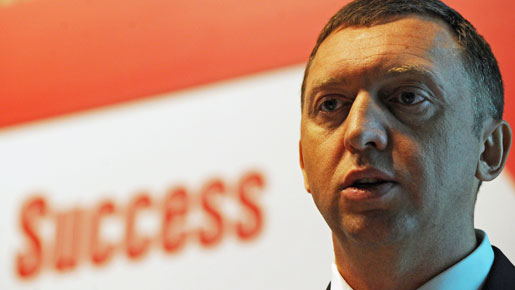
For someone who was in 2008 listed by Forbes as the ninth richest man in the world, Oleg Deripaska’s beginnings couldn’t be more humble. His mother, an engineer, was widowed when Deripaska was four and raised him alone on a small farm in the southern province of Krasnodar Krai. Life at university in Moscow was also a struggle: “We had no money. It was a very practical question every day. How do I get money to buy food and keep studying?” he told the Guardian in 2007.
He started working on building sites to bring in money and, deciding that his studies in theoretical physics were not going to take him anywhere, established himself as a metal trader. Shortly afterwards, he bought up 20 percent of the shares in Sayanagorsk Aluminium Smelter, and became engaged in a power struggle with the management board, who were holding out against capitalism. However, their resistance was futile; Deripaska became one of the most powerful oligarchs of Russia’s new elite.
Deripaska is an intensely private man, only giving one or two interviews per year. By keeping himself out of the limelight, he has managed to keep the details of his rise to the top somewhat obscured; on the one hand, it is clear that when he became involved in Sayanagorsk, despite being given the cold shoulder by the management board, he managed to relate to the workers, preventing them from going on strike and boosted production. What is less clear is how he managed to crush the Russian Mafia in the so-called ‘Aluminium Wars’, and it is a subject that he eschews if possible, brushing off most claims about that time as ‘jokes’ or fanciful stories. The smelter would later become the core of his extensive business empire.
In 2000, his friend and some time business partner, Roman Abramovich bought up most of the shares in the Russian Aluminium market, and merged with Deripaska’s company to form Rusal. These shares were then sold on to Deripaska, who formed investment giant, Basic Element. He is still the CEO and sole owner of the company, which, through shrewd investment on his part, has acquired important assets all over the globe, including car manufacturer GAZ Group, Russian Hotels and, of course, Rusal.
However, all has not been plain sailing. Deripaska recently fell to 164th place on the Forbes report, having apparently lost $24.5bn of his fortune between May 2008 and November 2009. The causes for this sudden and massive drop are many and varied. In 2008, he purchased a 25 percent stake in Norilsk Nickel, using money loaned from western banks. Come 2009, share prices fell by 80 percent, resulting in him having to apply for a $4.5bn loan from the Russian state bank when his original creditors demanded an increased repayment rate. Indeed, in 2009, it appeared that his debts might destroy him, even as he divested vast assets to regain capital. Towards the end of 2009, things began to look up as he renegotiated his debts and announced the $3bn floatation of Rusal in Hong Kong. He is once again amongst the top 100 billionaires as listed by Forbes in March 2010, having regained just over $7.5bn of his wealth.
He is not completely out of the woods yet though: He has been engaged in legal proceedings with Czech insurance magnate and billionaire Petr Kellner since 2008 over repercussions resulting from Deripaska’s offloading assets to try and manage his large debts. Kellner has won two cases against Deripaska, one in 2008 for diluting his shares in insurance company Ingosstrakh, another in January of this year regarding improper dealings of Deripaska’s holding company Basel Holdings 240 transactions with ‘interested parties’, which he forced through in May 2009. Another former business partner, Michael Cherney, also sued him for $4bn in the High Court in London in 2006 but, after three years of wrangling, the case was thrown out.
Outside of the world of industry, and away from this controversy, Deripaska has demonstrated his concern both for the environment and for the next generation of businessmen and entrepreneurs. Along with 15 other global business leaders, he drafted a document outlining the international business community’s propositions for effectively combating climate change. The proposal, endorsed by over 100 of the world’s leading firms, was presented to the then Japanese Prime Minister, Yasuo Fukada, for consideration by the upcoming G8 summit, hosted by Japan. He is the sole founder of Russia’s largest charitable foundation, Vol’noye dyelo (the Free Business Fund), a charity that funds over 400 programs in Russia, promoting and developing education, science and the preservation of cultural heritage. In conjunction with Roman Abramovich and Alexander Mamut he founded the Russian Science Support Foundation in 2000. The foundation aims to strengthen the links between scientific research and the Russian industry complex, and provides funds for talented Russian scientists and young researchers, enabling them to further scientific progress in the country.
Oleg V. Deripaska is not a man without his share of controversies, but his talent for keeping himself out of the public eye means that he is able to dispel most as rumours. Despite the grim predictions made about his future in 2009, he has resuscitated his business and is once again climbing the rich list – perhaps to regain his spot as Russia’s richest man, where he sat in 2008. It would not be imprudent to say that both he and his companies will be major players in the world economy for a long time to come.

